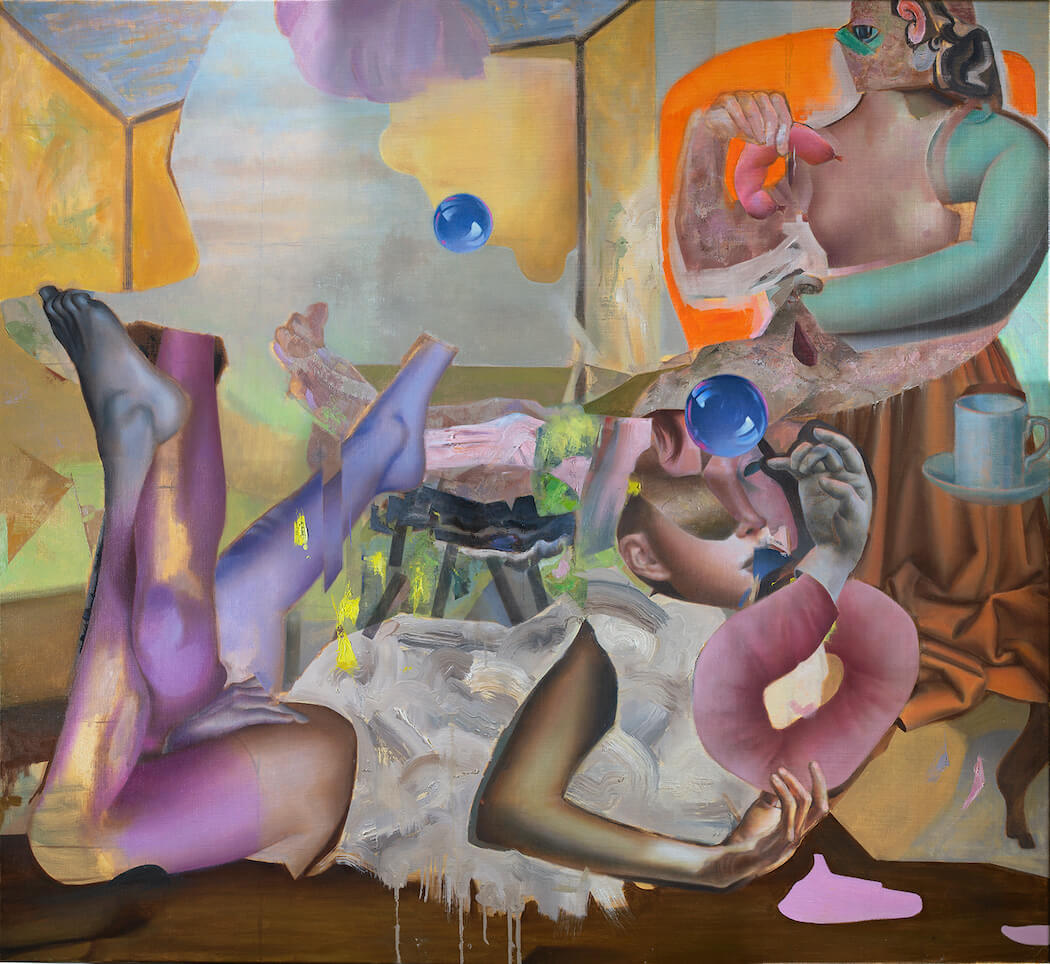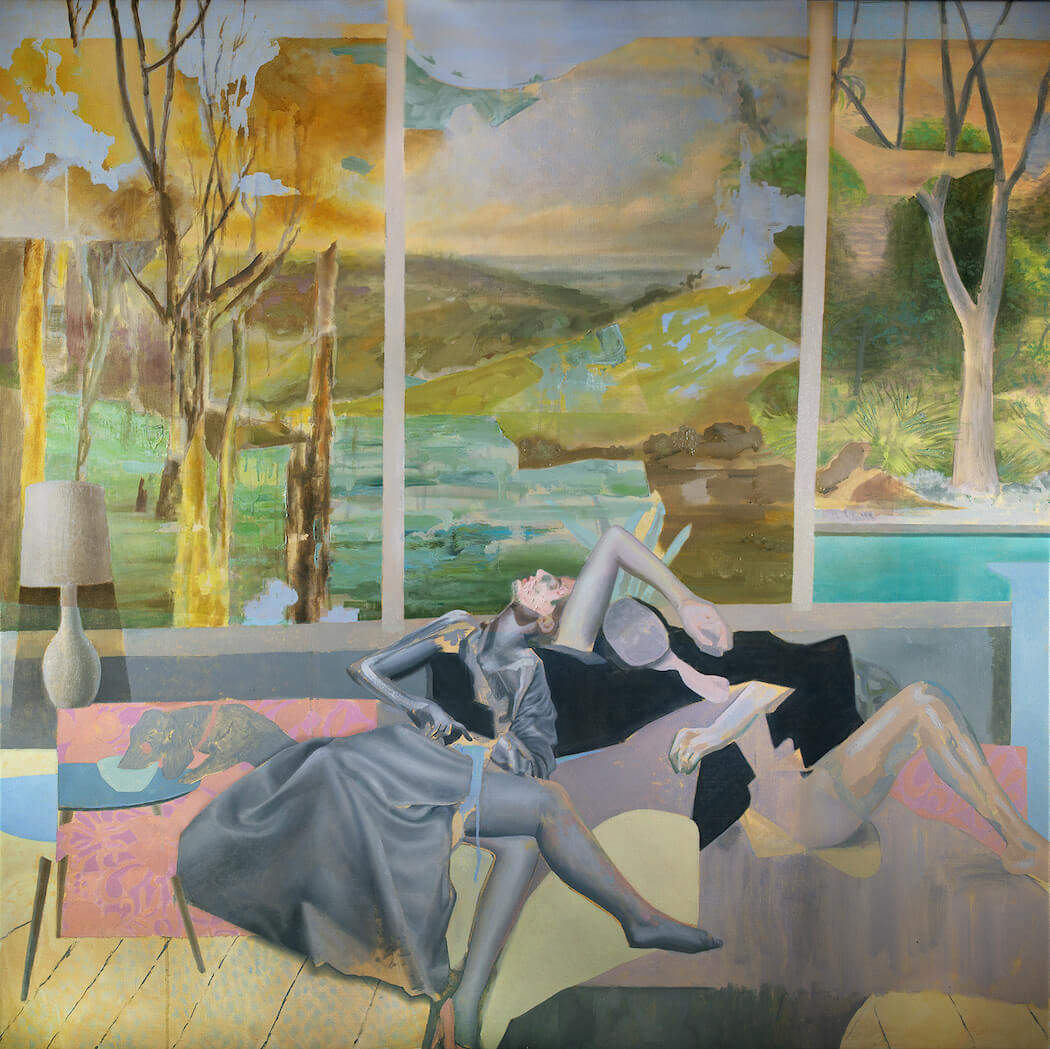I’ve been a fan of Kirstine Reiner Hansen’s work for a few years. She has a unique way of distorting the pristine beautiful figures that she paints and creates a space where the past and the future collide. I’m very happy to present you this interview, that should have happened a long time ago!

oil on linen
110×120 cm / 43.3×47.3 in.
perspectives for the new world
In her latest body of work, Kirstine Reiner Hansen continues to draw on the strategies and manipulations of fashion and media, mashed up with art history, exploring identity and connections. The artist appropriates imagery from magazines and advertising as a visual reference, conjoined with art historical elements, from renaissance paintings to the modernists in collage-like paintings. Narratives whose format appears ambiguous have crept into the latest work, and often involve multiple figures that are distorted and broken, surrounded by turbulence as they seek to retain some solidity… and glamour.

86×130 cm / 33.8×51 in.
How do you start your day?
My cat makes her presence known in no uncertain terms, giving me no other choice than to get up. Strong black tea with soy milk while keeping up with the outside world, followed by some pressing tasks, then slowly making my way into the studio.
If you were to paint one thing over and over what would it be?
I have a preoccupation with hands and drapery. Hands are like autonomous creatures, capable of amazingly diverse positions. Because I most often appropriate them from fashion or renaissance paintings they gesticulate in elegant, contrived, often pointless ways. Drapery can take on shapes resembling geological maps or landscapes, the dimensional abstraction is really useful for my compositions, and it’s an indulgence to paint them.
Do you like exhibiting your work?
It can be nerve-wracking, in the best possible way of course, especially if I have to give an artist talk. Talking about your work is a very different thing than making it. But I welcome the opportunity to meet and talk to supporters of my art in person. It’s exciting when your work offers an opportunity for questions and contemplation for other people.
What is your favourite place to think about a new painting?
A relaxing, undisturbed place is ideal, although that can be hard to find sometimes. When I’ve spent a lot of time in the studio it seems like ideas can come from anywhere as your mind is open and searching for clues.

oil on linen
100×110 cm / 39×43 in.

oil on canvas
70×90 cm / 27.5×35.4 in.
What is your relation to past painters, and history of art?
When I first started thinking of myself as an artist, I had this immature and false idea that art could only be truly original if you were not influenced by other artists. Of course, now I recognize how indebted I am to my first impressions, the art I was exposed to as a child; the modernists, surrealists, dadaists. In my paintings I appropriate small pieces of art historical paintings, in a way refreshing those unrecognizable parts, giving them a new context.
Which question would you like to ask your painting Idol?
Francis Bacon would have to explain how he managed to paint masterpieces with a hangover.
How did you develop this work you’re doing now?
For several years I haven’t spent much time in nature. Even before Corona. Maybe this is why I am drawn to narratives with windows to outside landscapes. More figures are introduced into the paintings too. Getting ideas can come while leafing through favourite art books in an almost meditative state, just letting visual information sieve in. Or I might create a photo folder on the computer with images that are especially interesting and useful at the moment, viewing them the same way. Duccio, Braque, Picasso, De Kooning, Elmer Bischoff are repeat inspirations.
How did you meet your favourite collector?
Most often the collectors communicate through the galleries, so I don’t get to know them.

oil on canvas
73×100.5 cm / 28.8 x39.5 in.

95x150cm / 37.4×59 in.
Why do we still paint in 2021?
I think, no matter what, as long as artists are excited about painting, there will be people excited about looking at a painting. It’s such a direct form of human expression, it will always be relevant. This moment seems to be a fantastic time for contemporary painting.
Where is Painting heading?
In terms of different kinds of art-making, painting in particular, the art world seems more inclusive now than ever. Also, hopefully, we will see more painting by women and artists of colour included in collections and museums. I’m sure right now many painters are playing with ideas of how to bring the painting into virtual reality realms.
Can you tell me 3 colleagues whose work you admire?
Dan Schein, Paul Gagner, Per Adolfsen.

oil on canvas
70×60 cm / 27.6×23.6 in.

oil on linen
50.8×81 cm /20×32 in.
BIOGRAPHY:
Kirstine Reiner Hansen is a Danish artist based in Berlin, Germany and Denmark. Born in Odense, Denmark, she received a BA in Design and Illustration at Kolding School of Design. She spent 15 years in the US, where her work has been exhibited in numerous galleries, most recently with a solo show at Jack Fischer Gallery in San Francisco. She is also represented by Gallery in Essen, Germany. In 2012 she received the Lillian Orlowsky and William Freed Foundation Grant and was twice a semi-finalist for the Outwin Boochever Portrait Competition. Her work has been featured in Juxtapoz Magazine, BloPop Magazine and The Asian Curator Magazine, as well as being featured in the book ‘Disrupted Realism – Paintings For A Distracted World’ by John A. Seed.
Thank you Kirstine, and thank you, reader.
All images belong to the Artist.
www.reinerhansen.com
Instagram @reinerhansenart

oil on linen
92×110 cm / 36×43 in.

